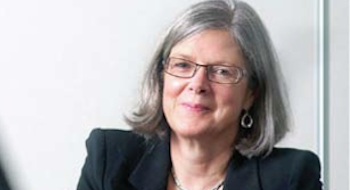

To outsiders, cross-country skiing may seem like a calm, low-stress activity. But many trails have unexpected challenges for even experienced skiers.
“There are trails with some short but terrifying hills. There are some where you can’t see some of the hill from the top,” says Julie Cays, chief investment officer of the Colleges of Applied Arts and Technology (CAAT) Pension Plan. “And you don’t have edges [as in downhill skiing], so you’re not carving your way down the hill. You just get on the tracks and go. It’s exhilarating.”
While Cays enjoys the sport today, it wasn’t so long ago that the thought of it made her freeze with panic. She was over 40 when she resolved to conquer her fears of heights and speed in order to spend more time with her family, all avid cross-country skiers. She met that goal through years of dedication and small steps: first going out with an instructor and then spending each weekend conquering the trails at her own pace. “I now seek out hills that are called things like Terminator and Eliminator and Vertigo,” she says proudly.
Having the confidence to ski up a hill is as important as being able to ski down it, Cays explains—even when you can’t see what’s on the other side. In many ways, this is an apt metaphor for pension investing.
The CAAT Pension Plan, a $5.5-billion DB plan whose members include employees at Ontario’s 24 colleges of applied arts and technology, has undergone some major changes over the past few years to ensure that it’s equipped to face the instability of investment markets. Chief among these changes—and what Cays views as her proudest career achievement—has been altering the way the fund’s investment committee looks at governance and risk.
“It’s not about focusing on what our investment managers are doing relative to the TSX, what bets they’re making. It’s how much we should have in equities, in infrastructure, in real return bonds.”
Cays says she’s drawn on her ability to take complicated but important pieces of information and present them clearly to help the fund’s investment committee, comprised mostly of college representatives without a formal investing background, understand where the risks are in the fund versus its liabilities. This, in turn, has helped the committee create policy designed to keep the plan on sound footing over the long term.
Despite her extensive track record of success over more than 20 years in pensions and investments—Cays worked with CIBC and the Healthcare of Ontario Pension Plan prior to joining CAAT in 2006—it wasn’t her first career choice.
“My dad was a chorister in the U.K. at Durham Cathedral [an icon of Romanesque architecture built in 1093]. Music was everywhere in our house. We sang in the church choir; I played the piano and French horn.”
When it was time to decide on post-secondary education, Cays considered studying math at the University of Waterloo in Ontario, hoping to combine the computer science elements of the program with her love of music.
“It turned out that I wasn’t all that good at the computer science part of the math program, so that changed,” says Cays, who instead earned a BA in economics and eventually became a CFA.
One of the most important lessons Cays has learned is that life throws a lot of curves, both personally and professionally. Her ability to adapt and change course has served her well over the years. “I’ve never been terribly good at plotting out either my career or my personal life, but I think I’ve made good choices.”
Neil Faba is associate editor of Benefits Canada. neil.faba@rci.rogers.com
